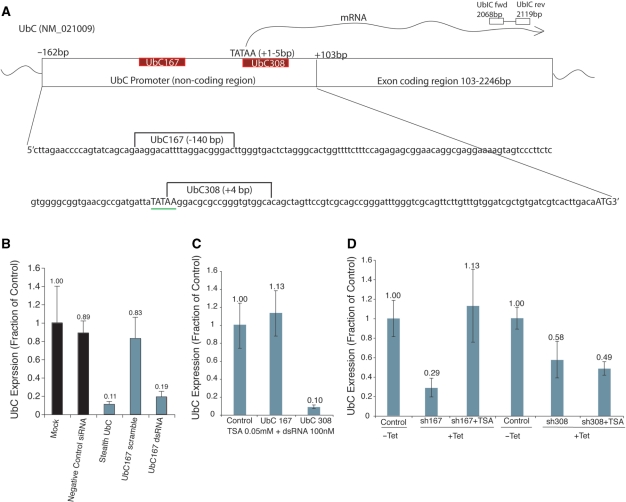Figure 1.
Transcriptional silencing of UbC. (A) The UbC promoter and exon 1 are shown schematically with the target sites UBC167 and UBC308, TATAA signal, transcriptional start site, and primary qPCR primers. (B) Promoter targeting with dsRNA is effective and specific. 293Gt cells were transfected with either an siRNA targeting the UbC coding region (Stealth UBC), a scrambled UBC167 promoter-targeted dsRNA (UBC167 scramble), or the original UBC167 dsRNA, and samples were analyzed by qRT-PCR for UbC mRNA levels 48 h later. Results were standardized to GAPDH levels, and quadruplicate treated cultures were assessed with the standard errors of the means shown. (C) UbC suppression by 167 targeting synthetic duplex RNAs is sensitive to TSA, while 308 targeting is not. 293Gt cells were transfected with CCR5 (control), UBC167 or UBC308 dsRNAs in triplicate. Twenty-four hours later cultures were treated with TSA (0.05mM). Forty-eight hours following TSA treatment the cultures were assessed for UbC expression standardized to GAPDH. Average values from triplicate transfected cultures with standard errors of the means are shown. (D) UbC suppression by a Tet-inducible UBC167 shRNA is sensitive to TSA treatment, while silencing by a similar UBC308 shRNA is not. 293Trex cells were transfected with either UBC167 or UBC308 expressing Tet-inducible plasmids, and treated with or without Tet. Twenty-four hours later these cultures were treated with TSA (0.05 mM). Forty-eight hours following TSA treatment the cultures were assessed for UbC mRNA levels standardized to GAPDH. Average values with standard errors of the means are shown.

